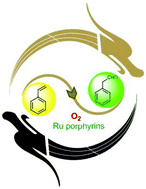A theoretical study on the oxidation of alkenes to aldehydes catalyzed by ruthenium porphyrins using O2 as the sole oxidant†
Abstract
Density functional theory (DFT) calculations were used to study the ruthenium porphyrin-catalyzed oxidation of styrene to generate an aldehyde. The results indicate that two reactive oxidants, dioxoruthenium and monooxoruthenium-superoxo porphyrins, participate in the catalytic oxidation. In the mechanism, the resultant monooxoruthenium porphyrin acts in the tandem epoxide isomerization (E-I) to selectively yield an aldehyde and generate a dioxoruthenium porphyrin, thereby triggering new oxidation reaction cycles. In this calculation, several key elements responsible for the observed oxidative ability have been established by using Frontier molecular orbital (FMO) theory, natural bond orbital (NBO) analysis, etc., which include the reaction energy, the spin exchange effect, the spin-state conversion process, and the energy level of the lowest unoccupied molecular orbitals (LUMOs) of the reactive oxidants. The comparative oxidative abilities of the ruthenium-oxo/superoxo compounds with different axial ligands are also investigated. The results suggest that the ruthenium-oxo/superoxo species featuring a chlorine axial ligand is more reactive than that substituted with oxygen. This tuneable reactivity can be understood when considering the different electronic characters of the two ligands and the effective atomic number rule (EAN).



 Please wait while we load your content...
Please wait while we load your content...